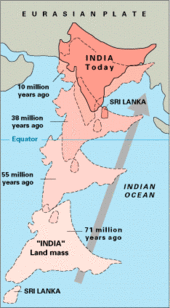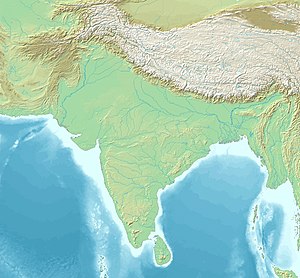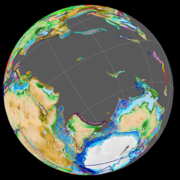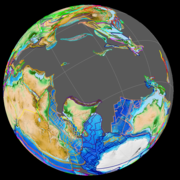Indian subcontinent
 Geopolitical coverage of the subcontinent | |
| Area | 4,440,000 km2 (1,710,000 sq mi) |
|---|---|
| Population | c. 1.9 billion |
| Demonym | South Asian Desi (colloquial) |
| Countries | |
| Dependencies | |
| Languages | |
| Time zones | List:
|
| Largest cities | |
The Indian subcontinent[note 7] is a physiographical region in Southern Asia, mostly situated on the Indian Plate, projecting southwards into the Indian Ocean from the Himalayas. Geopolitically, it spans major landmasses from the countries of Bangladesh, Bhutan, India,[note 1] the Maldives,[note 2] Nepal,[note 3] Pakistan,[note 4] and Sri Lanka.[note 2][1][2][3][4] The neighboring geographical regions around the subcontinent include the Tibetan Plateau to the north, the Indochinese Peninsula to the east, the Iranian Plateau to the west, and the Indian Ocean to the south. Although the terms "Indian subcontinent" and "South Asia" are often used interchangeably to denote the region,[5] the geopolitical term of South Asia frequently includes Afghanistan, which is not part of the subcontinent.[6]
Geologically, the subcontinent originates from Insular India, an isolated landmass that rifted from the supercontinent of Gondwana during the Cretaceous and merged with the Iranian Plateau and Eurasian Plate nearly 55 million years ago, forming the Himalayas.[7] Historically, as well as to the present day, it is and has been the most populated region in the world, holding roughly 20–25 percent of the global population at all times in history. Geographically, it is the peninsular region in Southern Asia located below the Third Pole, delineated by the Himalayas in the north, the Hindu Kush in the west, and the Indo-Burman Ranges in the east.[8]
Name
Historically, the region surrounding and southeast of the Indus River was often simply referred to as "India" in many historical sources. Even today, historians use this term to denote the entire Indian subcontinent when discussing history up until the era of the British Raj. Over time, however, "India" evolved to refer to a distinct political entity that eventually became a nation-state.[9]
According to the Oxford English Dictionary, the term subcontinent signifies a "subdivision of a continent which has a distinct geographical, political, or cultural identity" and also a "large land mass somewhat smaller than a continent".[10][11] Its use to signify the Indian subcontinent is evidenced from the early twentieth century when most of the territory was either part of the British Empire or allied with them.[12][13] It was a convenient term to refer to the region comprising both British India and the princely states.[14][15]
The term has been particularly common in the British Empire and its successors,[16] while the term South Asia is the more common usage in Europe and North America.[17][18] According to historians Sugata Bose and Ayesha Jalal, the Indian subcontinent has come to be known as South Asia "in more recent and neutral parlance".[19] Indologist Ronald B. Inden argues that the usage of the term South Asia is becoming more widespread since it clearly distinguishes the region from East Asia.[20] While South Asia, a more accurate term that reflects the region's contemporary political demarcations, is replacing the Indian subcontinent, a term closely linked to the region's colonial heritage, as a cover term, the latter is still widely used in typological studies.[21][22]
Since the Partition of India, citizens of Pakistan (which became independent of British India in 1947) and Bangladesh (which became independent of Pakistan in 1971) often perceive the use of the Indian subcontinent as offensive and suspicious because of the dominant placement of India in the term. As such it is being increasingly less used in those countries.[note 8] Meanwhile, many Indian analysts prefer to use the term because of the socio-cultural commonalities of the region.[24] The region has also been called the "Asian subcontinent",[25][26] the "South Asian subcontinent",[27][28][29] as well as "India" or "Greater India" in the classical and pre-modern sense.[5][6][30][31]
Geology

The Indian subcontinent was formerly part of Gondwana, a supercontinent formed during the late Neoproterozoic and early Paleozoic.[7] Gondwana began to break up during the Mesozoic, with Insular India separating from Antarctica 130-120 million years ago[32] and Madagascar around 90 million years ago,[33] during the Cretaceous. Insular India subsequently drifted northeastwards, colliding with the Eurasian Plate nearly 55 million years ago, during the Eocene, forming the Indian subcontinent.[7] The zone where the Eurasian and Indian subcontinent plates meet remains geologically active, prone to major earthquakes.[34][35]
Geography

According to anthropologist Patrap C. Dutta, "the Indian subcontinent occupies the major landmass of South Asia."[42] According to historian B. N. Mukherjee, "The subcontinent is an indivisible geographical entity."[43] According to geographer Dudley Stamp, "there is perhaps no mainland part of the world better marked off by nature as a region or a 'realm' by itself than the Indian subcontinent."[44]
This natural physical landmass in South Asia is the dry-land portion of the Indian Plate, which has been relatively isolated from the rest of Eurasia.[45] The Himalayas (from Brahmaputra River in the east to Indus River in the west), Karakoram (from Indus River in the east to Yarkand River in the west) and the Hindu Kush mountains (from Yarkand River westwards) form its northern boundary.[43][46] In the west it is bounded by parts of the mountain ranges of Hindu Kush, Spīn Ghar (Safed Koh), Sulaiman Mountains, Kirthar Mountains, Brahui range, and Pab range among others,[43] with the Western Fold Belt along the border (between the Sulaiman Range and the Chaman Fault) is the western boundary of the Indian Plate,[47] where, along the Eastern Hindu Kush, lies the Afghanistan–Pakistan border.[48] In the east, it is bounded by Patkai, Naga, Lushai and Chin hills.[43] The Indian Ocean, Bay of Bengal and Arabian Sea form the boundary of the Indian subcontinent in the south, south-east and south-west.[43]

Given the difficulty of passage through the Himalayas, the sociocultural, religious and political interaction of the Indian subcontinent has largely been through the valleys of Afghanistan in its northwest,[
Geopolitics
In terms of modern geopolitical boundaries, the subcontinent constitutes Bangladesh, Bhutan, India, Nepal, and Pakistan, besides, by convention, the island country of Sri Lanka and other nearby island nations of the Indian Ocean, such as Maldives and the British Indian Ocean Territory.[citation needed][original research?][2][3][49][50][51] Unlike "South Asia" sometimes the expression "Indian subcontinent" may exclude the islands of Maldives and Sri Lanka.[5] According to Chris Brewster and Wolfgang Mayrhofer, India, Pakistan, Bangladesh, Sri Lanka, Nepal and Bhutan constitute the Indian subcontinent. Brewster and Mayrhofer also maintain that with Afghanistan and Maldives included the region is referred to as South Asia.[52] The periphery of the subcontinent, including Pakistan, Bangladesh and the island chains of the Maldives, features large Muslim populations, while the heartland, including most of India, Nepal, and Sri Lanka, are overwhelmingly Hindu or Buddhist.[53] Since most of these countries are located on the Indian Plate, a continuous landmass, the borders between countries are often either a river or a no man's land.[54]
The precise definition of an "Indian subcontinent" in a geopolitical context is somewhat contested as there is no globally accepted definition on which countries are a part of South Asia or the Indian subcontinent.[55][56][57][4] Whether called the Indian subcontinent or South Asia, the definition of the geographical extent of this region varies.[30][31] Afghanistan, despite often considered as a part of South Asia, is usually not included in the Indian subcontinent.[55][58][59][60][61] Maldives, an island country consisting of a small archipelago southwest of the peninsula, while largely considered a part of the Indian subcontinent,[3] sometimes is mentioned by sources, including the International Monetary Fund, as a group of islands away from the Indian subcontinent in a south-western direction.[62][63]
See also
Notes
- ^ a b Excluding:
- Andaman and Nicobar Islands, which is a part of the Malay Archipelago.
- Ladakh, Spiti, and other areas which lie to the north of the Greater Himalayan Mountain Range.
- Significant portions of northeast India which lie on the Indo-Burman Ranges (spanning Manipur, Nagaland and Mizoram) as well as the Tibetan Plateau (northern Arunachal Pradesh and Sikkim)
- ^ a b c d As island countries, the Maldives and Sri Lanka are sometimes not considered part of the subcontinent, as they lack geographic contiguity with the mainland. They are considered parts of the region in cultural geography or geology instead.
- ^ a b Excluding Upper Mustang and other areas which lie to the north of the Greater Himalayan Mountain Range.
- ^ a b Excluding:
- Significant landmasses from East Balochistan and Khyber Pakhtunkhwa (like Federally Administered Tribal Areas) which are situated on the Iranian Plateau.
- Parts of Northern Areas (like Baltistan) which lie to the north of the Greater Himalayan Mountain Range.
- ^ Administered by the United Kingdom, claimed by Mauritius as the Chagos Archipelago.
- ^ Disputed territory with undetermined political status. Administration is split between China (Aksai Chin and the Trans-Karakoram Tract), India (Jammu and Kashmir, and Ladakh), and Pakistan (Azad Kashmir and Gilgit-Baltistan). China claims a small portion of the territory, Pakistan claims the majority of the territory, and India claims the entire territory (see: UN mediation of the Kashmir dispute).
- ^ It is sometimes simply just referred as the subcontinent in South Asian contexts.
- ^ For example, a history book intended for Pakistani B.A. students by K. Ali uses the term "Indo-Pakistan" instead.[23]
References
- ^ ISBN 0-19-860441-6) New York: Oxford University Press, 2001; p. 929: "the part of Asia south of the Himalayas which forms a peninsula extending into the Indian Ocean, between the Arabian Sea and the Bay of Bengal. Historically forming the whole territory of Greater India, the region is now divided into three countries named Bangladesh, India and Pakistan."
- ^ ISBN 978-0-19-537475-9.
- ^ ISBN 978-0-8020-9964-8.
- ^ ISBN 978-1-317-62445-5.
- ^ ISBN 0-313-31459-4. Note: McLeod does not include Afghanistan in the Indian subcontinent or South Asia.
- ^ ISBN 0-415-30787-2
- ^ ISBN 978-1-139-49920-0.
- ^ ISBN 978-1-134-93384-6,
This greater India is well defined in terms of topography; it is the Indian sub-continent, hemmed in by the Himalayas on the north, the Hindu Khush in the west and the Arakanese in the east.
- ^ "Indian subcontinent Map, Countries, Population, & History". Encyclopædia Britannica. 20 September 2022. Retrieved 23 August 2023.
- ^ Webster's Third New International Dictionary, Unabridged, Merriam-Webster, 2002. Retrieved 6 December 2016; Quote: "a large landmass smaller than a continent; especially: a major subdivision of a continent ! e Indian subcontinent | "
- ^ Subcontinent, Oxford English Dictionaries (2012). Retrieved 6 December 2016; Quote: "A large distinguishable part of a continent..."
- ISBN 0-8226-0034-X
- ^ "Indian subcontinent" is used by Henry D. Baker, British India With Notes On Ceylon Afghanistan And Tibet (1915), p. 401.
- ^ "subcontinent". Oxford English Dictionary (Online ed.). Oxford University Press. (Subscription or participating institution membership required.)
- ^ "Indian subcontinent". Oxford English Dictionary (Online ed.). Oxford University Press. (Subscription or participating institution membership required.)
- ISBN 0-19-513798-1
- ISBN 0750620501
- ISBN 0198568177
- ISBN 0415307872.
- ISBN 1850655200
- ISBN 9780198607717.
- ISBN 9781139851213.
- ^ Ali, K. (1980). A New History of Indo-Pakistan up to 1526 (4th ed.). Lahore: Aziz Publishers.
- ISBN 9789386367501"Indian analysts, who talk of the Indian sub-continent, wish to keep in mind, in their analyses, the common historical, political, religious and cultural heritage of these three countries. The term sub-continent is used less and less in Pakistan and Bangladesh. The political leadership and the policy-makers in these two countries do not wish to be reminded of this common heritage. Any highlighting of this common heritage by Indian analysts is viewed by them with suspicion—— as indicating a hidden desire to reverse history and undo the 1947 partition."
- ^ Lizzie Crouch and Paula McGrath, "Humanity's global battle with mosquitoes", Health check, BBC World Service
- ISBN 9781437929539
- ISBN 9788180695681
- ISBN 9780674028012.
- ISBN 9781782544159
- ^ ISBN 9781134593224
- ^ ISBN 9781134933846
- .
- S2CID 128896193.
- ISBN 978-1-61069-297-7.
- ISBN 978-0-8160-7270-5.
- ISBN 978-0-19-537475-9.
- ISBN 0-313-31459-4.
- ^ Pannell, Clifton W. (2009). "Asia". Encyclopædia Britannica.
The paleotectonic evolution of Asia terminated some 50 million years ago as a result of the collision of the Indian subcontinent with Eurasia. Asia's subsequent neotectonic development has largely disrupted the continents pre-existing fabric. The neotectonic units of Asia are Stable Asia, the Arabian and Indian cratons, the Alpide plate boundary zone (along which the Arabian and Indian platforms have collided with the Eurasian continental plate), and the island arcs and marginal basins.
- ^ E. Bredow, R. Gassmöller, J. Dannberg and B. Steinberger, Geodynamic Models of Plume-Ridge Interaction in the Indian Ocean and its Effect on the Crustal Thickness of the Réunion Hotspot Track (abstract), Astrophysics Data System (ADS), Harvard–Smithsonian Center for Astrophysics
- ISBN 9780195352177
- ^ ISBN 9781876410971
- ISBN 9780306414077.
- ^ ISBN 9788187498261
- OCLC 213547929.
- ^ ISBN 978-0-521-80904-7
- ISBN 9789400726321
- ISBN 9781862397033
- ISBN 978-90-481-2641-5.
- ISBN 978-0-19-537475-9. Archivedfrom the original on 21 February 2018. Retrieved 9 December 2016.
India, Pakistan, Bangladesh, Sri Lanka, Nepal, Bhutan and other small islands of the Indian Ocean
- ISBN 0-7614-7289-4.
- ISBN 978-0-415-14405-6.
The seven countries of South Asia constitute geographically a compact region around the Indian Subcontinent ... Nepal and Bhutan ... the Maldives
- ISBN 9780857938718
- ISBN 9789004162402
- ^ Chandra K. Sharma, Geology of Nepal Himalaya and Adjacent Countries, page 14, Sangeeta Sharma Books, 1990, ASIN B0006EWSCI
- ^ ISBN 978-1-136-64862-5., Quote: "To the east, Iran, as a Gulf state, offers a generally accepted limit to the Middle East. However, Afghanistan, also a Muslim state, is then left in isolation. It is not accepted as a part of Central Asia and it is clearly not part of the Indian subcontinent".
- ISBN 978-90-411-2214-8.
- ISBN 978-1-4959-4130-6
- ISBN 978-0-521-51430-9.
- ISBN 978-1-136-28493-9.
- ISBN 9781402012150. Retrieved 20 July 2022.
- ISBN 9780531144183. Retrieved 20 July 2022.
- ISBN 9783447047319, "Maldive Islands which are scattered about the sea south-west of the Indian subcontinent, extending over more than 1,000km in a north-south direction."
- ISBN 9781463979676, "Maldives is the smallest Asian country in both population and land area. Its closest neighbors to the north are India's Laccadive Islands. To the northeast is the Indian subcontinent and Sri Lanka. To the south it borders the British Indian Occan Territory. About 2.600 kilometers (1,600 miles) further east, across the Indian Ocean, is Malaysia. To the west, the Horn of Africais approximatcly 3,000 kilometers (1,300 miles) away."

















